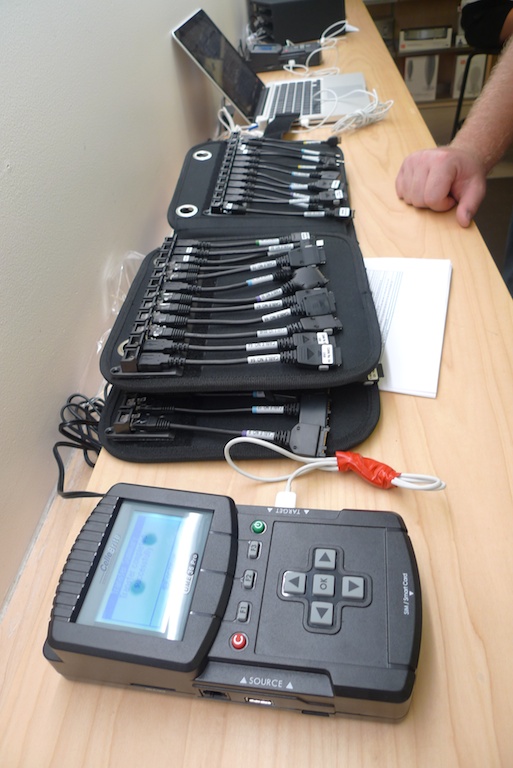More evidence that Apple's morphing into a phone company


According to the manufacturer's Web site, the cellebrite UME-36Pro (Universal Memory Exchanger) is:
a stand-alone phone memory transfer and backup device that transfers all forms of content, including pictures, videos, ringtones, SMS, as well as phonebook contact data between a wide range of mobile phones, smart phones and PDAs.
Pictured at the bottom is the machine itself, above it is a binder with about 50 different types of adapters for just about every mobile phone conceivable. The printed cheat sheet underneath allows Apple staff to look up a particular phone model and quickly find the corresponding dongle.
The dongles terminate to a USB or RJ45 connector which plugs into the UME-36Pro unit which extracts the data and passes it to a waiting iPhone on the other side. The UME-36Pro boasts native iPhone 4 support and can even transfer data via IrDA and Bluetooth.
Voila! Address book transferred, no iTunes required.
But "Wait a second!" I can almost hear you asking, "How can cellebrite send data directly to an iPhone while mere mortals are forced to use iTunes?" I posed this very question to cellebrite and will update this post when I hear back from the company.
The telling part is what the UME-36Pro offers to retailers:
- New sources of revenue
- Rapid ROI
- Enhanced quality of service
- Increased customer retention and monthly activation
- An easy way to remove customer hesitation re: upgrading to new phones, applications and services- even from complex multimedia models
- Elimination of barriers to switching networks
Those bullets tell the real story: Apple is morphing into a full-blown mobile phone company right before our very eyes.
In 2007 most people that bought the original iPhone were existing, brand-loyal Apple customers. They were people that purchased most products that Apple made and, well, Newton owners.
In 2008 the iPhone 3G was purchased by all of the above, plus technology-lovers fascinated by all the hype surrounding touchscreen phones and people whose contracts finally expired.
In 2009 the iPhone 3GS was purchased by all of the above plus late adopters, Luddites plus a few Windows/Unix zealots in denial.
In 2010 the iPhone 4 is being purchased by all of the above plus 9-year-olds, parents, grandparents, great-grandparents, very late adopters and completely non-technical people whose old-school Nokia freebie finally gave up the ghost.
As the potential iPhone market gets saturated Apple needs to appeal to more and different types of mobile phone customers. The iPhone is no longer the domain of the technical elite, or heck, even computer people. Everyone has heard of the iPhone and many people want one but there are still some barriers to overcome including: carrier contracts, old handset that just won't die and Apple haters.
Nothing will probably win over that last group but as more contracts expire and as more old Nokia beaters begin to stop charging (or get the inevitable water baptism), people find their way into an Apple store asking about the iPhone. And thanks to the Universal Memory Exchanger, Apple is now able to "remove customer hesitation" and "eliminate barriers" to switching.